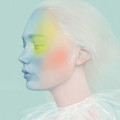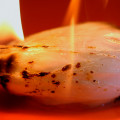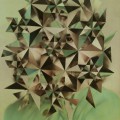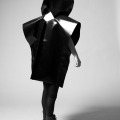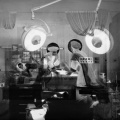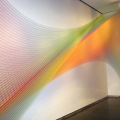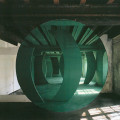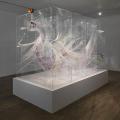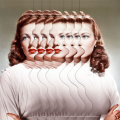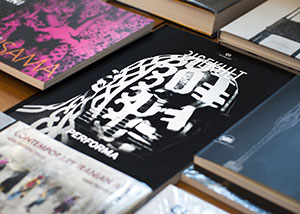The term “still life” appears late and refers to a broad genre of painting wrongly regarded as minor because hardly focused on the representation of a social and religious order, and less valued in terms of academic technicalities.
Yet, the representation of inanimate objects is a particularly fertile territory of experimentation. When we think of the representations of flowers, fruits, tables, everyday objects, instrument of science, trompe l’oeil, curio cabinets or pieces of architecture, we understand that this discipline has continually evolved, according to the moods of painters and fashion, up to our times.
Encouraged by the founding myths of painting, the illusionistic representation was the privileged place for experimentation and formal jokes. False perspectives, fake nails, fake flies, false shadows and false drops or tasks paint are inseparable from the true ones. This is where the “more done” coincides with the “less done”; undermining in passing the gradations of realism that common sense has naively attributed to the painting between representation and abstraction.
The “still-life painting” or “painting paint” is a feature that focuses on itself the question of representation; might want to say understanding the world through its appearance.
When and how the “still life” would be trasformed from “observation of the object” to the “object from the observation” ?
This, without cutting the historical legacy, and most importantly, without ceasing to be a game.
These paradoxes act as connecting elements, from the larger opening to the synthesis. They are the essential core of Linda Carrara’s painting.
***
The works of Linda Carrara live alone or in networks. They have the ability of extending outside their inside propagation modes. Structures, lines, counterpoint, mass and texture, form a material that unfolds and folds, forming an ecosystem. They incorporate the architecture of the exhibition space. A too visible window, staircase or item of furniture naturally find their places in this dynamic organization.
The color is on a second level because they are not illusionist works through images. They are illusionist by organization. The organization that allows life. As an organ. And these works are alive by the way they act in their environment, and therefore on us. These are traps for the mind. Neuroncatchers.
Nothing is more tempting to mind than completing what is lacking and synthesizing what is complete.
That is why these paintings grow malignantly the lack and the excess. Their balance is dynamic.
It is not strictly a part of the composition that grows asymmetry and disruption, but the tension that moves their forms.
And that’s why their arrangement in space is so precise.
In some of Linda Carrara’s works,the combination of geometric and organic shows no technical virtuosity, but the enigma remains powerful for the modern mind inhabited by the antagonism of life and machine, and claiming to control the world through its reason.
The set is often ethereal without plastic qualities. This is a vanity.
It seeks correspondences and projects its light gray on his surroundings.
Looking ‘behind’ a vertical medium size canvas, there is an humanoid form with a simple umbrella on two-tone bluish gray background, which I understood as “I am a still-life” . It is recognized recognizable, brushed black legs that could be shod by the Doc Martens of the painter. Instead of the torso, sketch rays in a circular structure on raw white canvas.
At its center, the shadow of a schematic hand that seems to hold together this cyclopean shape that became a figure. The umbrella shape become the structure that protects the body’s visibility. It is the structure that makes the body its own shade, and a still-life portrait.
It is a self-portrait in still-life that is watching us.
The objects represented by Linda Carrara do not come from everyday life. They are the primary forms from a suggestive power.
That’s why they assemble into a metastructure and compose their own combination while requesting the visible world.
This still-life no longer refers to the inanimate everyday objects. This is the painting itself that became the object, of unknown origin, ageless, and endlessly processable. The painting itself is made malleable to offer long questioning look.
The object of representation has always been a conveyor of thought. Taking as its subject, observing the painting itself, painting became subject, object and medium of its own representation. It is in this sense that painting is a super reflective medium.
In the contemporary world, the traditional categories are obsolete. Whoever seeks a new classicism could find there some serious benchmark
***
Looking at the work of Linda Carrara it appears that “the most powerful painting” needs the simplest subjects. And, deeper “the painting”, more space is required. The complexity is lost if it is not based on the delicate balance of Emptiness and Simplicity.
This still-Life is the one of the unique object. Of the object like the outline of the object. Of the object as an idea, and the idea in the state of meditation.. A container. A receptacle whose geometry varies with the depth we put in.
By analogy, one wonders if the depth of cosmic void is not the spot of thought.
There is a recurring motif in this painting. It is a black surface mottled or a surface crossing some single lines. Gerhard Richter has practised it in grey. Alex Katz has practised it like rain brushed in some melancholic landscapes. Sam Francis, Jackson Pollock and Henri Matisse had dressed emptiness with sparse tasks. Carrara uses Emptiness as a base from which she returns regularly to compose a subject. Emptiness as a trunk. As a unique place of experimentation. As a base, a land, a starting point.


















